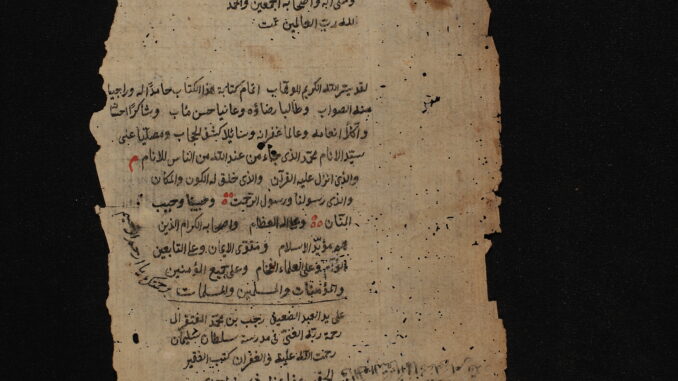
Andrew Peacock, University of St Andrews[1]
The library of La Ode Zaenu gives a unique window into the intellectual culture of this part of Indonesia, and provides an interesting complement the better known collection in Bau-Bau of Abdul Mulku Zahari. The latter was catalogued some time ago (Achadiati Ikram et al, Katalog Naskah Buton: Koleksi Abdul Mulku Zahari (Jakarta, 2010) and has been partially digitised by a project in the British Library’s Endangered Archives Programme. In contrast, the La Ode Zaenu collection remained almost totally unknown to the outside world until the work of DREAMSEA in digitising it.
Even a cursory examination reveals this is a very different sort of collection to the Abdul Mulku Zahari one. Whereas the 300 odd manuscripts in the latter are divided roughly equally between those in Arabic, the regional lingua franca of Malay, and the local court language of Wolio, the La Ode Zaenu collection is overwhelmingly in Arabic. Probably about 80% of the surviving manuscripts (or fragments of manuscripts) are in Arabic with almost all of the remainder in Malay; only a handful are in Wolio. It seems likely this linguistic divide reflects the interests of the families who collected the manuscripts. The family of Abdul Mulku Zahari was closely associated with the sultan’s court, and Abdul Mulku Zahari was himself secretary to the last sultan, whereas La Ode Zaenu was an imam.

Most of the manuscripts in the La Ode Zaenu collection appear to be copied in Buton. Some of them indeed, are Arabic works by sultan Muhammad Aydarus (r. 1821-1854), the leading figure in intellectual life in nineteenth-century Buton, who wrote voluminously on Sufism and hadith. However, a handful of manuscripts come from much further afield and therefore contribute to our understanding of Buton’s links with the wider Islamic world. For instance, one manuscript (MLZ 75), a collection of Arabic works on hadith, fiqh and Sufism, was copied by a Hadrami resident of Melaka in the Malay peninsula, ‘Abd al-Rahman bin ‘Umar bin Muhammad Ba Ridwan, in 1821-2.
However, the oldest manuscript in the collection points to Butonese connections much further west. This is MLZ 43, which bears a statement on the colophon that it was copied in ‘the madrasa of Sultan Suleyman’ in 1081AH/1670CE. While the city is not specified, this can only be the madrasa attached to the Süleymaniye complex in Istanbul, named after Sultan Suleyman the Magnificent (r. 1520-1566). This supposition is confirmed by marginal and interlinear notes on the manuscript which are in Turkish, clearly indicating it must have originated in the Turkish-speaking parts of the Ottoman lands (and not, for example, the Hijaz, where Arabic predominated).

The text of the manuscript is unusual too, for Southeast Asia. It is in fact a fragment of a copy of al-Tariqa al-Muhammadiyya (The Muhammadan Way) by the Ottoman preacher Mehmed Birgevi (d. 1573). This text, which was designed to encourage piety in daily life, was enormously popular in the Middle East, where it also provoked numerous commentaries, but it was almost entirely unknown in Southeast Asia. In his work Birgevi took a strong stand against many of the Sufi practices current in his day, including the performance of vocal dhikr (the incantation of God’s name). It is interesting, and surprising, to find such a text on Buton, where Sufi practices, including dhikr, were embedded into local political practices. Exactly how the manuscript made its way to Buton we can only surmise; most likely, after being copied in Istanbul it was sold to an owner who then sold it on in the Hijaz, where it probably fell into the hands of Southeast Asians, of whom there was a large community studying in Arabia. One way or another, however, it is testimony to the ways in which the local manuscript culture of Buton was also bound to the intellectual currents of the broader Islamic world.
Note:
[1] The author gratefully acknowledges financial support for this research through the British Academy;’s Mid Career Fellowship Scheme

University of St Andrews

Peradaban leluhur kita sangat tinggi n luar biasa 👍👍👍.
Cara pengarsipan koleksi juga sangat teliti sehingga masih bisa dibaca hingga kini.
Salam rawat bangun peradaban bangsa Indonesia🇲🇨📚📖📝